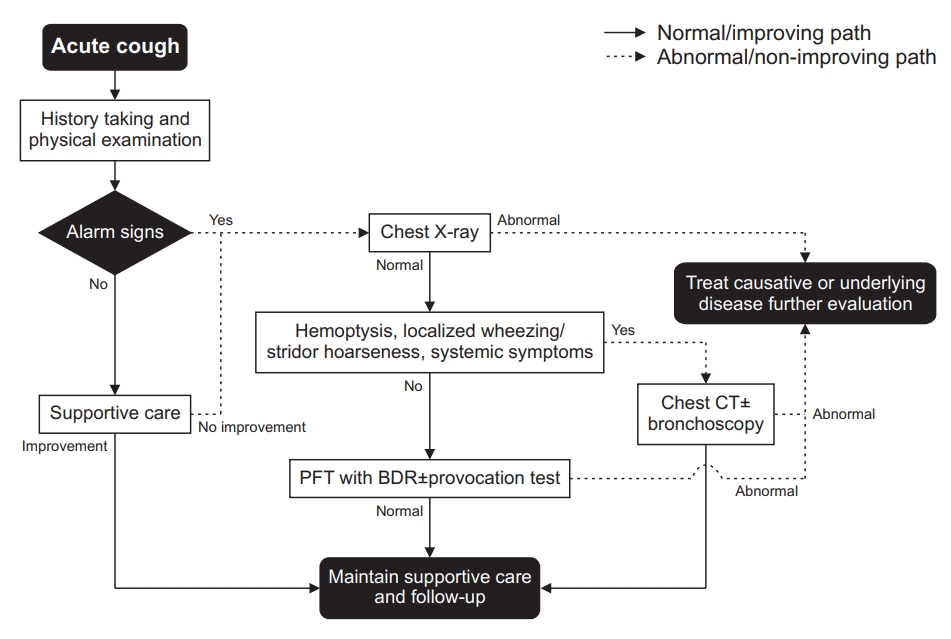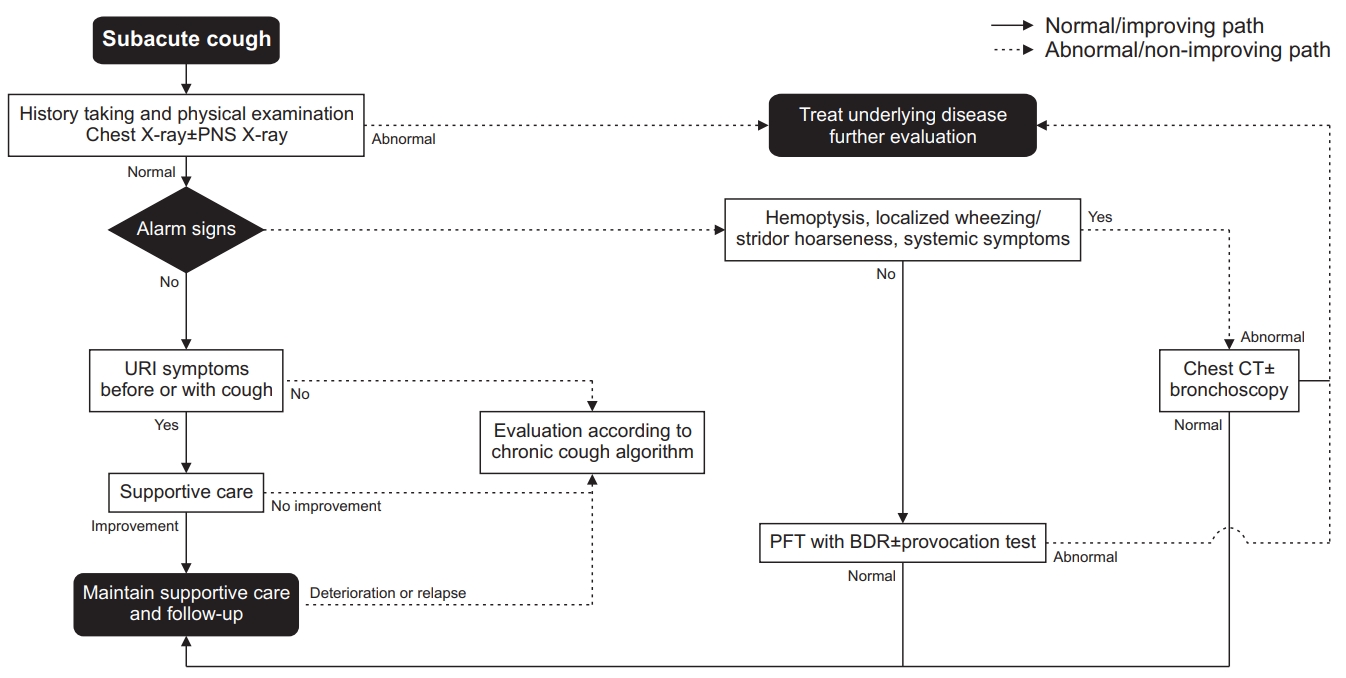1. Irwin RS, French CT, Lewis SZ, Diekemper RL, Gold PM; CHEST Expert Cough Panel. Overview of the management of cough: CHEST Guideline and Expert Panel Report. Chest 2014;146:885-9.


2. Irwin RS. Complications of cough: ACCP evidence-based clinical practice guidelines. Chest 2006;129(1 Suppl):54S-8S.


4. Pratter MR, Brightling CE, Boulet LP, Irwin RS. An empiric integrative approach to the management of cough: ACCP evidence-based clinical practice guidelines. Chest 2006;129(1 Suppl):222S-31S.


5. Irwin RS, French CL, Chang AB, Altman KW; CHEST Expert Cough Panel. Classification of cough as a symptom in adults and management algorithms: CHEST Guideline and Expert Panel report. Chest 2018;153:196-209.

6. Koo HK, Jeong I, Kim JH, Kim SK, Shin JW, Park SY, et al. Development and validation of the COugh Assessment Test (COAT). Respirology 2019;24:551-7.


7. Lee KK, Matos S, Evans DH, White P, Pavord ID, Birring SS. A longitudinal assessment of acute cough. Am J Respir Crit Care Med 2013;187:991-7.


8. Hsu JY, Stone RA, Logan-Sinclair RB, Worsdell M, Busst CM, Chung KF. Coughing frequency in patients with persistent cough: assessment using a 24 hour ambulatory recorder. Eur Respir J 1994;7:1246-53.


10. Armstrong GL, Pinner RW. Outpatient visits for infectious diseases in the United States, 1980 through 1996. Arch Intern Med 1999;159:2531-6.


11. Braman SS. Postinfectious cough: ACCP evidence-based clinical practice guidelines. Chest 2006;129(1 Suppl):138S46S.
12. Asthma Workgroup; Chinese Society; Respiratory, Diseases (CSRD); Chinese Medical, Association. The Chinese national guidelines on diagnosis and management of cough (December 2010). Chin Med J (Engl) 2011;124:3207-19.

13. Committee for the Japanese Respiratory Society Guidelines for Management of Cough, Kohno S, Ishida T, Uchida Y, Kishimoto H, Sasaki H, et al. The Japanese Respiratory Society guidelines for management of cough. Respirology 2006;11 Suppl 4:S135-86.

15. Morice AH, McGarvey L, Pavord I; British Thoracic Society Cough Guideline Group. Recommendations for the management of cough in adults. Thorax 2006;61 Suppl 1:i1-24.


16. Pratter MR, Bartter T, Akers S, DuBois J. An algorithmic approach to chronic cough. Ann Intern Med 1993;119:977-83.


17. Irwin RS, Curley FJ, French CL. Chronic cough. The spectrum and frequency of causes, key components of the diagnostic evaluation, and outcome of specific therapy. Am Rev Respir Dis 1990;141:640-7.


18. Morice AH. Post-nasal drip syndrome: a symptom to be sniffed at? Pulm Pharmacol Ther 2004;17:343-5.


19. Pratter MR, Bartter T, Lotano R. The role of sinus imaging in the treatment of chronic cough in adults. Chest 1999;116:1287-91.


20. Cote A, Russell RJ, Boulet LP, Gibson PG, Lai K, Irwin RS, et al. Managing chronic cough due to asthma and NAEB in adults and adolescents: CHEST Guideline and Expert Panel report. Chest 2020;158:68-96.


21. Bateman ED, Hurd SS, Barnes PJ, Bousquet J, Drazen JM, FitzGerald JM, et al. Global strategy for asthma management and prevention: GINA executive summary. Eur Respir J 2008;31:143-78.


22. Gibson PG, Dolovich J, Denburg J, Ramsdale EH, Hargreave FE. Chronic cough: eosinophilic bronchitis without asthma. Lancet 1989;1:1346-8.


23. Brightling CE, Ward R, Goh KL, Wardlaw AJ, Pavord ID. Eosinophilic bronchitis is an important cause of chronic cough. Am J Respir Crit Care Med 1999;160:406-10.


24. Khan BA, Sodhi JS, Zargar SA, Javid G, Yattoo GN, Shah A, et al. Effect of bed head elevation during sleep in symptomatic patients of nocturnal gastroesophageal reflux. J Gastroenterol Hepatol 2012;27:1078-82.


28. Kanner RE, Connett JE, Williams DE, Buist AS. Effects of randomized assignment to a smoking cessation intervention and changes in smoking habits on respiratory symptoms in smokers with early chronic obstructive pulmonary disease: the Lung Health Study. Am J Med 1999;106:410-6.


29. Wynder EL, Kaufman PL, Lesser RL. A short-term follow-up study on ex-cigarette smokers: with special emphasis on persistent cough and weight gain. Am Rev Respir Dis 1967;96:645-55.

30. Malesker MA, Callahan-Lyon P, Madison JM, Ireland B, Irwin RS; CHEST Expert Cough Panel. Chronic cough due to stable chronic bronchitis: CHEST Expert Panel report. Chest 2020;158:705-18.


31. Cazzola M, Floriani I, Page CP. The therapeutic efficacy of erdosteine in the treatment of chronic obstructive bronchitis: a meta-analysis of individual patient data. Pulm Pharmacol Ther 2010;23:135-44.


32. Calverley P, Pauwels R, Vestbo J, Jones P, Pride N, Gulsvik A, et al. Combined salmeterol and fluticasone in the treatment of chronic obstructive pulmonary disease: a randomised controlled trial. Lancet 2003;361:449-56.


33. McGuinness G, Naidich DP. CT of airways disease and bronchiectasis. Radiol Clin North Am 2002;40:1-19.


34. Serisier DJ, Martin ML, McGuckin MA, Lourie R, Chen AC, Brain B, et al. Effect of long-term, low-dose erythromycin on pulmonary exacerbations among patients with non-cystic fibrosis bronchiectasis: the BLESS randomized controlled trial. JAMA 2013;309:1260-7.


35. Altenburg J, de Graaff CS, Stienstra Y, Sloos JH, van Haren EH, Koppers RJ, et al. Effect of azithromycin maintenance treatment on infectious exacerbations among patients with non-cystic fibrosis bronchiectasis: the BAT randomized controlled trial. JAMA 2013;309:1251-9.


36. Wong C, Jayaram L, Karalus N, Eaton T, Tong C, Hockey H, et al. Azithromycin for prevention of exacerbations in non-cystic fibrosis bronchiectasis (EMBRACE): a randomised, double-blind, placebo-controlled trial. Lancet 2012;380:660-7.


37. Evans DJ, Bara AI, Greenstone M. Prolonged antibiotics for purulent bronchiectasis in children and adults. Cochrane Database Syst Rev 2007;(2):CD001392.


38. Brown KK. Chronic cough due to nonbronchiectatic suppurative airway disease (bronchiolitis): ACCP evidence-based clinical practice guidelines. Chest 2006;129(1 Suppl):132S-7S.


39. Shure D. Radiographically occult endobronchial obstruction in bronchogenic carcinoma. Am J Med 1991;91:19-22.


41. Temel JS, Greer JA, Muzikansky A, Gallagher ER, Admane S, Jackson VA, et al. Early palliative care for patients with metastatic non-small-cell lung cancer. N Engl J Med 2010;363:733-42.


43. Robbins J, Coyle J, Rosenbek J, Roecker E, Wood J. Differentiation of normal and abnormal airway protection during swallowing using the penetration-aspiration scale. Dysphagia 1999;14:228-32.


44. Grouzmann E, Monod M, Landis B, Wilk S, Brakch N, Nicoucar K, et al. Loss of dipeptidylpeptidase IV activity in chronic rhinosinusitis contributes to the neurogenic inflammation induced by substance P in the nasal mucosa. FASEB J 2002;16:1132-4.


45. Landis BN, Grouzmann E, Monod M, Busso N, Petak F, Spiliopoulos A, et al. Implication of dipeptidylpeptidase IV activity in human bronchial inflammation and in bronchoconstriction evaluated in anesthetized rabbits. Respiration 2008;75:89-97.


46. Israili ZH, Hall WD. Cough and angioneurotic edema associated with angiotensin-converting enzyme inhibitor therapy: a review of the literature and pathophysiology. Ann Intern Med 1992;117:234-42.


47. Lacourciere Y, Brunner H, Irwin R, Karlberg BE, Ramsay LE, Snavely DB, et al. Effects of modulators of the renin-angiotensin-aldosterone system on cough. Losartan Cough Study Group. J Hypertens 1994;12:1387-93.

48. Dicpinigaitis PV. Angiotensin-converting enzyme inhibitor-induced cough: ACCP evidence-based clinical practice guidelines. Chest 2006;129(1 Suppl):169S-73S.


50. Bryon M, Jaffe A. Disabling cough: habit disorder or tic syndrome? Lancet 2003;361:1991-2.

51. Weinberger M. Disabling cough: habit disorder or tic syndrome? Lancet 2003;361:1991.

52. Weinberger M. The habit cough syndrome and its variations. Lung 2012;190:45-53.


54. Gay M, Blager F, Bartsch K, Emery CF, Rosenstiel-Gross AK, Spears J. Psychogenic habit cough: review and case reports. J Clin Psychiatry 1987;48:483-6.

55. Blager FB, Gay ML, Wood RP. Voice therapy techniques adapted to treatment of habit cough: a pilot study. J Commun Disord 1988;21:393-400.


56. Cohlan SQ, Stone SM. The cough and the bedsheet. Pediatrics 1984;74:11-5.


57. Birring SS, Kavanagh JE, Irwin RS, Keogh KA, Lim KG, Ryu JH, et al. Treatment of interstitial lung disease associated cough: CHEST Guideline and Expert Panel report. Chest 2018;154:904-17.


58. Tarlo SM, Altman KW, Oppenheimer J, Lim K, Vertigan A, Prezant D, et al. Occupational and environmental contributions to chronic cough in adults: Chest Expert Panel report. Chest 2016;150:894-907.


59. Joint Committee for the Revision of Korean Guidelines for Tuberculosis Korea Centers for Disease Control and Prevention. Korean guidelines for tuberculosis. 4th ed. Seoul: Joint Committee for the Revision of Korean Guidelines for Tuberculosis, Korea Centers for Disease Control and Prevention; 2020.
65. Holley JL, Piraino B. CAPD-associated cough. Perit Dial Int 1995;15:392-3.


66. Min F, Tarlo SM, Bargman J, Poonai N, Richardson R, Oreopoulos D. Prevalence and causes of cough in chronic dialysis patients: a comparison between hemodialysis and peritoneal dialysis patients. Adv Perit Dial 2000;16:129-33.

67. Tarlo SM. Peritoneal dialysis and cough. Perit Dial Int 2003;23:424-6.


68. Twardowski ZJ, Khanna R, Nolph KD, Scalamogna A, Metzler MH, Schneider TW, et al. Intraabdominal pressures during natural activities in patients treated with continuous ambulatory peritoneal dialysis. Nephron 1986;44:129-35.


70. Maschmeyer G, Beinert T, Buchheidt D, Einsele H, Heussel CP, Kiehl M, et al. Diagnosis and antimicrobial therapy of pulmonary infiltrates in febrile neutropenic patients: guidelines of the Infectious Diseases Working Party (AGIHO) of the German Society of Hematology and Oncology (DGHO). Ann Hematol 2003;82 Suppl 2:S118-26.

71. Prakash UB. Uncommon causes of cough: ACCP evidencebased clinical practice guidelines. Chest 2006;129(1 Suppl):206S-19S.


73. Pratter MR. Unexplained (idiopathic) cough: ACCP evidence-based clinical practice guidelines. Chest 2006;129(1 Suppl):220S-1S.


74. Hull JH, Menon A. Laryngeal hypersensitivity in chronic cough. Pulm Pharmacol Ther 2015;35:111-6.


75. Vertigan AE, Bone SL, Gibson PG. Laryngeal sensory dysfunction in laryngeal hypersensitivity syndrome. Respirology 2013;18:948-56.


76. Vertigan AE, Gibson PG, Theodoros DG, Winkworth AL. A review of voice and upper airway function in chronic cough and paradoxical vocal cord movement. Curr Opin Allergy Clin Immunol 2007;7:37-42.


77. Hull JH, Backer V, Gibson PG, Fowler SJ. Laryngeal dysfunction: assessment and management for the clinician. Am J Respir Crit Care Med 2016;194:1062-72.


78. Blitzer A, Brin MF. Laryngeal dystonia: a series with botulinum toxin therapy. Ann Otol Rhinol Laryngol 1991;100:85-9.


79. Gibson PG, Ryan NM. Cough pharmacotherapy: current and future status. Expert Opin Pharmacother 2011;12:1745-55.


80. Bolser DC. Mechanisms of action of central and peripheral antitussive drugs. Pulm Pharmacol 1996;9:357-64.


82. Rogers DF. Mucoactive agents for airway mucus hypersecretory diseases. Respir Care 2007;52:1176-93.












 PDF Links
PDF Links PubReader
PubReader ePub Link
ePub Link Full text via DOI
Full text via DOI Print
Print Download Citation
Download Citation



